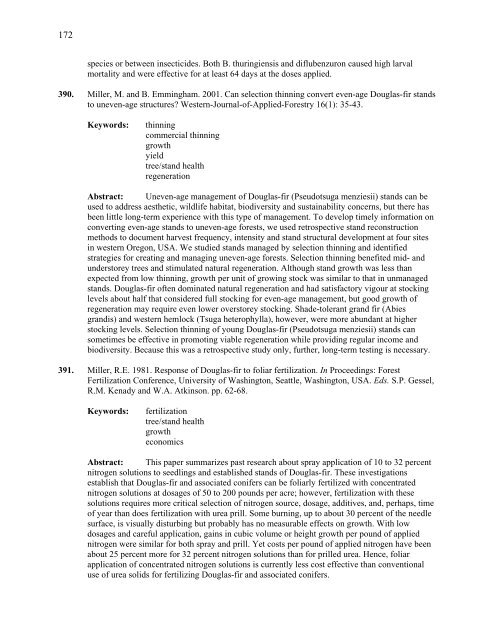IntensIve sIlvIculture - Forest Science Labs - Research Network ...
IntensIve sIlvIculture - Forest Science Labs - Research Network ...
IntensIve sIlvIculture - Forest Science Labs - Research Network ...
You also want an ePaper? Increase the reach of your titles
YUMPU automatically turns print PDFs into web optimized ePapers that Google loves.
172<br />
species or between insecticides. Both B. thuringiensis and diflubenzuron caused high larval<br />
mortality and were effective for at least 64 days at the doses applied.<br />
390. Miller, M. and B. Emmingham. 2001. Can selection thinning convert even-age Douglas-fir stands<br />
to uneven-age structures? Western-Journal-of-Applied-<strong>Forest</strong>ry 16(1): 35-43.<br />
Keywords: thinning<br />
commercial thinning<br />
growth<br />
yield<br />
tree/stand health<br />
regeneration<br />
Abstract: Uneven-age management of Douglas-fir (Pseudotsuga menziesii) stands can be<br />
used to address aesthetic, wildlife habitat, biodiversity and sustainability concerns, but there has<br />
been little long-term experience with this type of management. To develop timely information on<br />
converting even-age stands to uneven-age forests, we used retrospective stand reconstruction<br />
methods to document harvest frequency, intensity and stand structural development at four sites<br />
in western Oregon, USA. We studied stands managed by selection thinning and identified<br />
strategies for creating and managing uneven-age forests. Selection thinning benefited mid- and<br />
understorey trees and stimulated natural regeneration. Although stand growth was less than<br />
expected from low thinning, growth per unit of growing stock was similar to that in unmanaged<br />
stands. Douglas-fir often dominated natural regeneration and had satisfactory vigour at stocking<br />
levels about half that considered full stocking for even-age management, but good growth of<br />
regeneration may require even lower overstorey stocking. Shade-tolerant grand fir (Abies<br />
grandis) and western hemlock (Tsuga heterophylla), however, were more abundant at higher<br />
stocking levels. Selection thinning of young Douglas-fir (Pseudotsuga menziesii) stands can<br />
sometimes be effective in promoting viable regeneration while providing regular income and<br />
biodiversity. Because this was a retrospective study only, further, long-term testing is necessary.<br />
391. Miller, R.E. 1981. Response of Douglas-fir to foliar fertilization. In Proceedings: <strong>Forest</strong><br />
Fertilization Conference, University of Washington, Seattle, Washington, USA. Eds. S.P. Gessel,<br />
R.M. Kenady and W.A. Atkinson. pp. 62-68.<br />
Keywords: fertilization<br />
tree/stand health<br />
growth<br />
economics<br />
Abstract: This paper summarizes past research about spray application of 10 to 32 percent<br />
nitrogen solutions to seedlings and established stands of Douglas-fir. These investigations<br />
establish that Douglas-fir and associated conifers can be foliarly fertilized with concentrated<br />
nitrogen solutions at dosages of 50 to 200 pounds per acre; however, fertilization with these<br />
solutions requires more critical selection of nitrogen source, dosage, additives, and, perhaps, time<br />
of year than does fertilization with urea prill. Some burning, up to about 30 percent of the needle<br />
surface, is visually disturbing but probably has no measurable effects on growth. With low<br />
dosages and careful application, gains in cubic volume or height growth per pound of applied<br />
nitrogen were similar for both spray and prill. Yet costs per pound of applied nitrogen have been<br />
about 25 percent more for 32 percent nitrogen solutions than for prilled urea. Hence, foliar<br />
application of concentrated nitrogen solutions is currently less cost effective than conventional<br />
use of urea solids for fertilizing Douglas-fir and associated conifers.
















